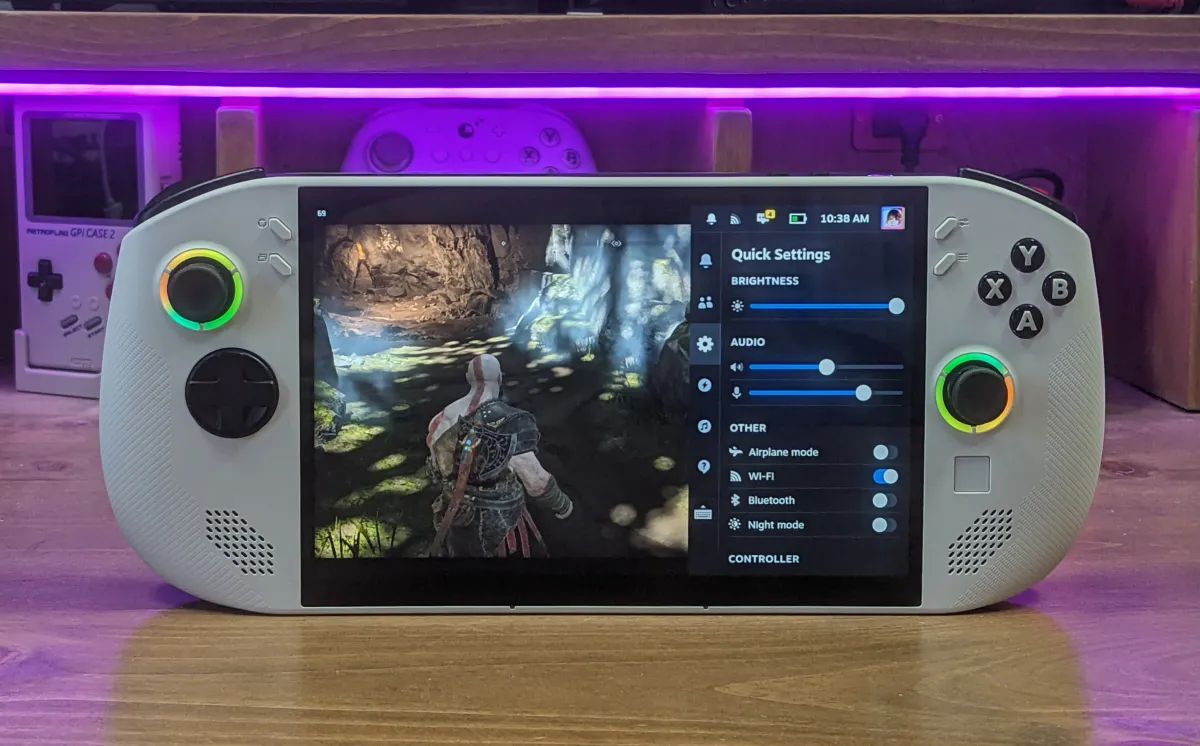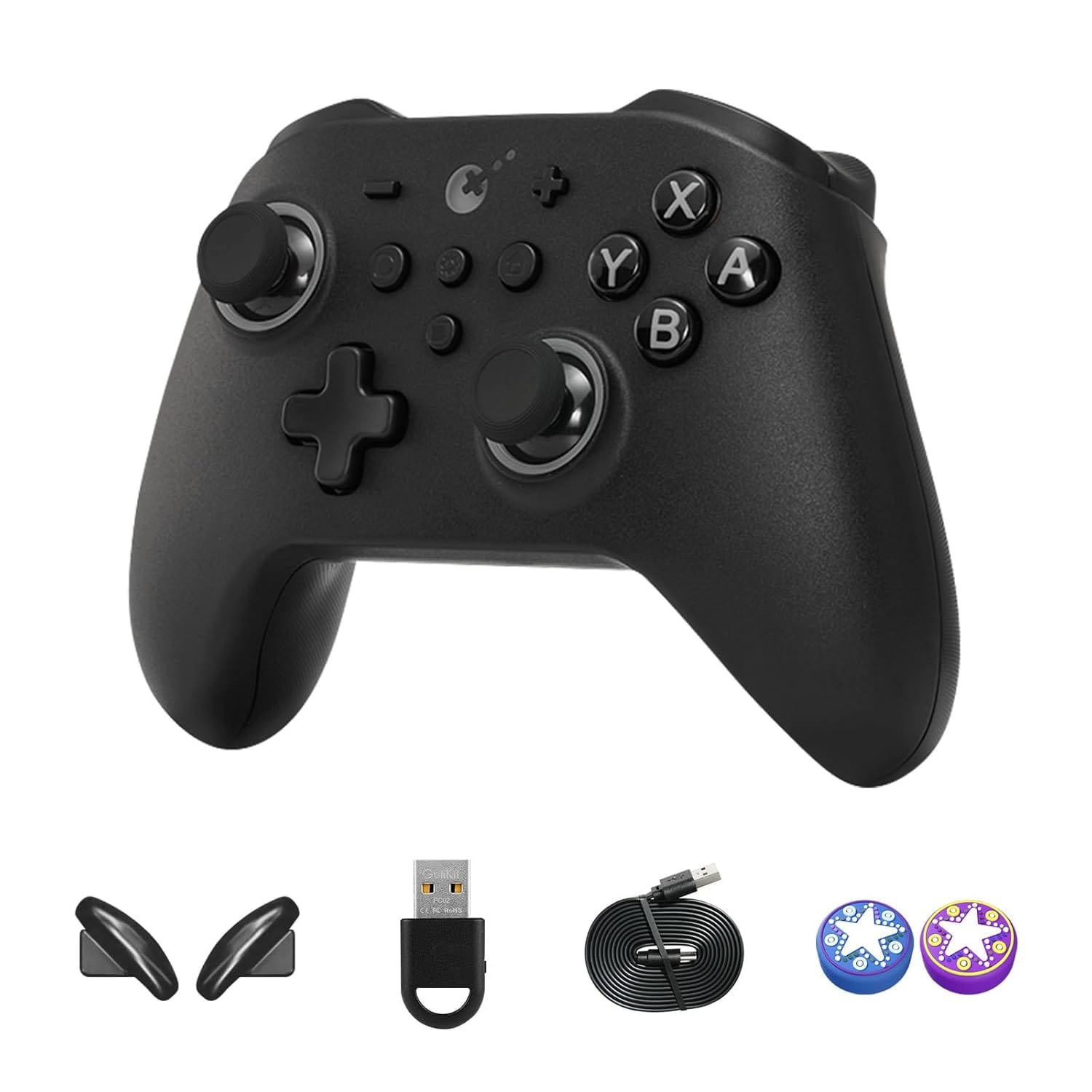Hands-on with the Lenovo Legion Go S
Lenovo sent me the Windows variant of the Legion Go S and said I can do anything I want with it. So I put Bazzite on it.

So Lenovo sent me their Legion Go S with Windows and it's an interesting device that's worthy of discussion. First off, let's talk about the specs. (And for a point of comparison, I'm including the Steam Deck OLED's specs here.)
| Legion Go S | Steam Deck OLED | |
|---|---|---|
| CPU |
AMD Ryzen Z2 Go 4 cores, 8 threads @ 4.4 GHz |
AMD Ryzen Zen 2 4 cores, 8 threads @ 3.5 GHz |
| GPU | 12 RDNA 2 CUs | 8 RDNA 2 CUs |
| RAM | 32 GB 6400MHz LPDDR5X | 16 GB 6400MHz LPDDR5 |
| Display | 8" IPS LCD touchscreen 1920x1200 120Hz VRR 500 nits |
7.4" HDR OLED touchscreen 1280x800 90Hz 600 nits (SDR), 1,000 nits (HDR) |
| Internal Storage | 1TB PCIe SSD Gen 4 | Up to 1TB NVMe SSD |
| External Storage | microSD card slot | microSD card slot |
| Physical Connectivity | 2 USB4 Type C ports 40Gb/s, DisplayPort 1.4, USBPD 3.0 |
1 USB3 Gen 2 Type C port DisplayPort 1.4 |
| Wireless Connectivity | WiFi 6E 802.11AX (2x2) Bluetooth 5.3 |
WiFi 6E 802.11AX (2X2) Bluetooth 5.3 |
| Battery | 55.5WHr | 50WHr |
Initial Experience
When I first got the Go S, I unboxed it on camera and booted it up. It ships with Windows–which was expected–and I decided to give the device's native experience a whirl.
During the (arduous and unforgivable) Windows 11 Out of Box setup process, Microsoft reminded me that the Go S comes with 3 months of complementary PC Game Pass.
The PC Game Pass Detour
Given that I've never tried PC Game Pass before, I decided to sign up. Most of the games I tried to play through PCGP ended up either not working or were completely bugged out which I found quite amusing.
I tried Call of Duty 4: Modern Warfare–which failed when I tried to start a new game.
Then I noticed that Gears of War: Ultimate Edition for Windows 10 was included in Game Pass. This game is nearly 20 years old and I thought "surely, this has gotta work."
It wouldn't even launch to the splash screen. It just completely failed with an "Error code 19." I tried googling the issue but nothing helpful came up. I tried upgrading the drivers but they were already current. I also tried rebooting the Go S but the game simply refused to launch.
The only title I was able to get working was Crash Bandicoot N. Sane Trilogy which I already own on Steam and which also performed better through Steam.
I don't think any of this is Lenovo's fault, but it is hard to determine where the problem lies. (Though, my insane anti-Microsoft bias encourages me to believe that it's Microsoft's fault.)
Back on Track
Once I had my fill of the PC Game Pass sewage (and as amusement turned into that familiar, trademark, Microsoft-inspired frustration) I turned my focus to replacing Windows 11 with a good Operating System.
After some finagling (and a replacement handheld from Lenovo's support due to a UEFI issue, more on that in a bit) I was able to get Bazzite installed and running on this device without any issue.
In order to get Bazzite installed, you'll need:
- A USB flash drive 10+ GB
- A USB keyboard
- And you'll probably need a USB type C hub in order to connect the other devices to the Legion Go S
Installation was pretty straightforward. I've made a video about that which you can check out here:
Bazzite is tremendous on the Go S. This is the power of the open source community–supporting a handheld like this with what I believe is better than first party levels of support.
Everything I can think of works. We've got RGB control, fan curves, performance tweaking, video out over USB, full controller support, touchscreen & touchpad, motion control, it's all here.
Controls & Inputs
Speaking of the controller, every button works with Bazzite. And the Bazzite menu (accessed via the R4 button on the rear of the device while in a game) allows this controller to emulate an Xbox, DualSense, or even the Steam Controller. That's really neat.
The analog sticks use Hall Effect sensors which feel great. Though it should be noted that they don't have capacitive touch and that's a step backwards compared to the Steam Deck. Capacitive touch enables new and novel methods of control that have absolutely spoiled me as a gamer.
The D-pad here works alright but I could argue about its placement. The face buttons are laid out in the typical Xbox-style arrangement and have a nice tactile feel to them. The bumpers are clicky and feel great to engage (even better than the Steam Deck's bumpers), while the triggers have a rather shallow action. The triggers can be converted into digital buttons using physical sliders on the rear. This is a nifty trick that the Gulikit KK 3 Pro and Max (which I reviewed last year) are also capable of.
I truly love this feature as it allows the triggers to adapt based on different styles of games.
The function buttons (menu, view, home, and quick access) activate tack switches that have an audible click to them. They feel decent to engage, though their arrangement is vertically mirrored compared to the Steam Deck. This has been a small hurdle for my muscle memory to overcome.
I'm happy to report that I was able to get rumble working in games by setting the emulated controller type to "Steam Controller."
The haptics feel pretty decent, too.

